1995 CHEVROLET CAMARO fuel
[x] Cancel search: fuelPage 80 of 388
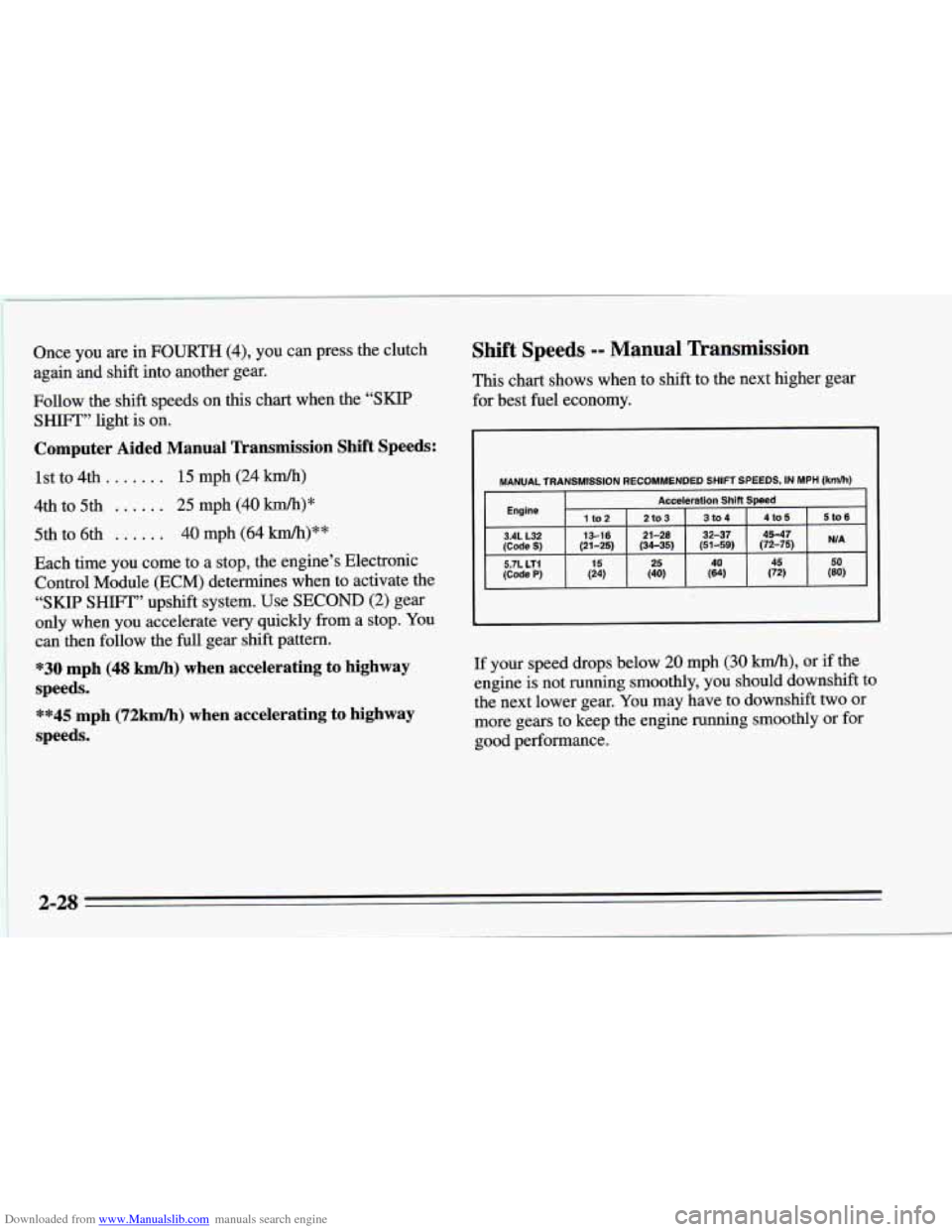
Downloaded from www.Manualslib.com manuals search engine Once you are in FOURTH (4), you can press the clutch
again
and shift into another gear.
Follow the shift speeds on
this chart when the ‘‘SKIP
SHIFT” light is on.
Computer Aided Manual Transmission Shift Speeds:
1st to 4th. . . . . . . 15 mph (24 km/h)
4th to 5th . . . . . . 25 mph (40 km/h)*
5th to 6th . . . . . . 40 mph (64 km/h)**
Each time you come to a stop, the engine’s Electronic
Control Module (ECM) determines when to activate the
“SKIP SHIFT” upshift system. Use SECOND (2) gear
only when you accelerate very quickly from a stop. You
can then follow the full gear shift pattern.
*30 mph (48 km/h) when accelerating to highway
speeds.
**45 mph (72km/h) when accelerating to highway
speeds.
Shift Speeds -- Manual Transmission
This chart shows when to shift to the next higher gear
for best fuel economy.
MANUAL TRANSMISSION RECOMMENDED SHIFT SPEEDS, IN MPH (kmlh)
Acceleration Shift Speed Engine 1 to 2 2t03 3 to 4 4tO 5 5 to 6
3.4L L32 13-1 6 21-28 32-37 45-47 (Code S) (21-25) (34-35) (51-59) (72-75) NIA
If your speed drops below 20 mph (30 km/h), or if the
engine is not running smoothly, you should downshift to
the next lower gear. You may have to downshift two
or
more gears to keep the engine running smoothly or for
good performance.
2-28
~-
Page 118 of 388
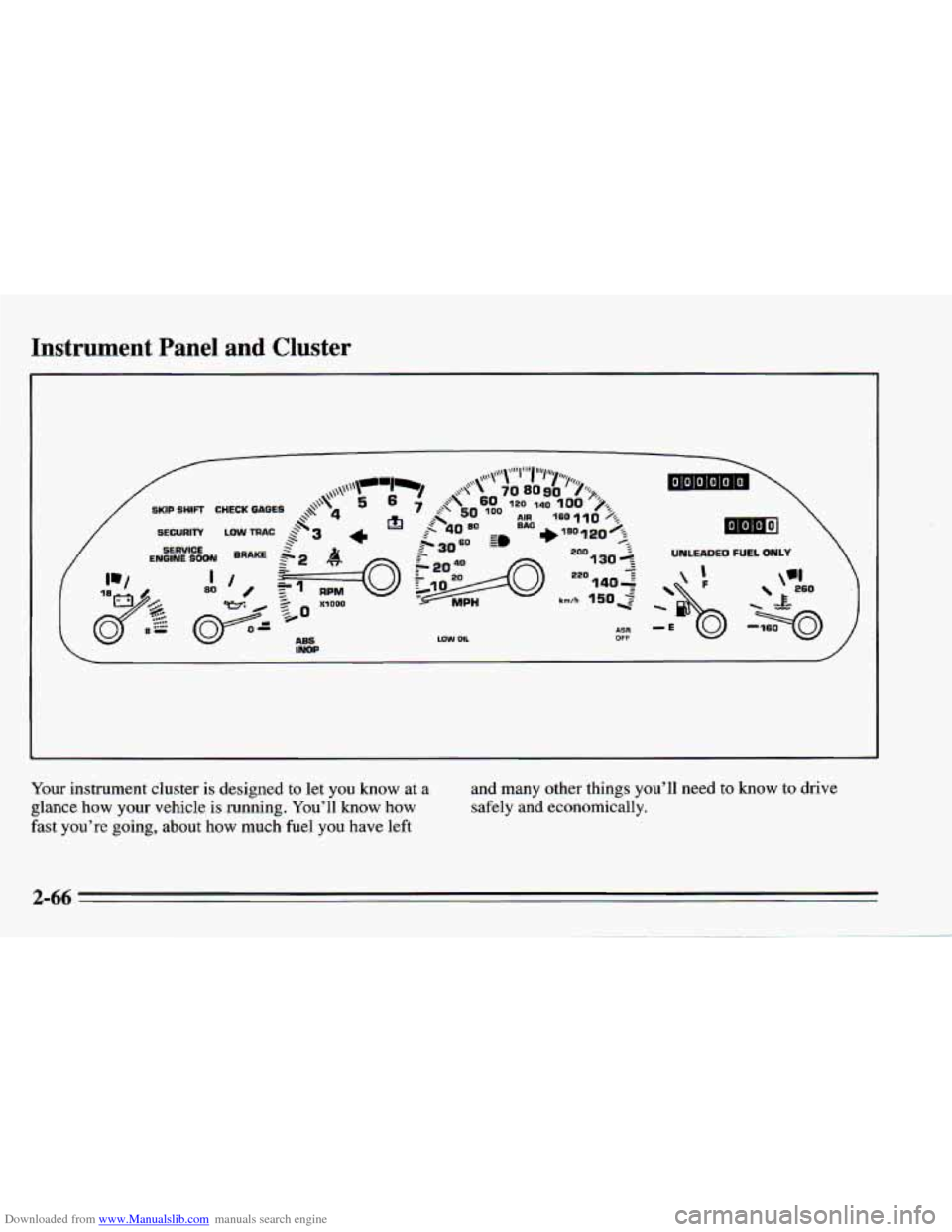
Downloaded from www.Manualslib.com manuals search engine Instrument Panel and Cluster
Your instrument cluster is designed to let you know at a
glance how your vehicle is running. You’ll
know how
fast you’re going, about how much fuel you have left and
many other things you’ll need
to know to drive
safely and economically.
2-66
Page 126 of 388
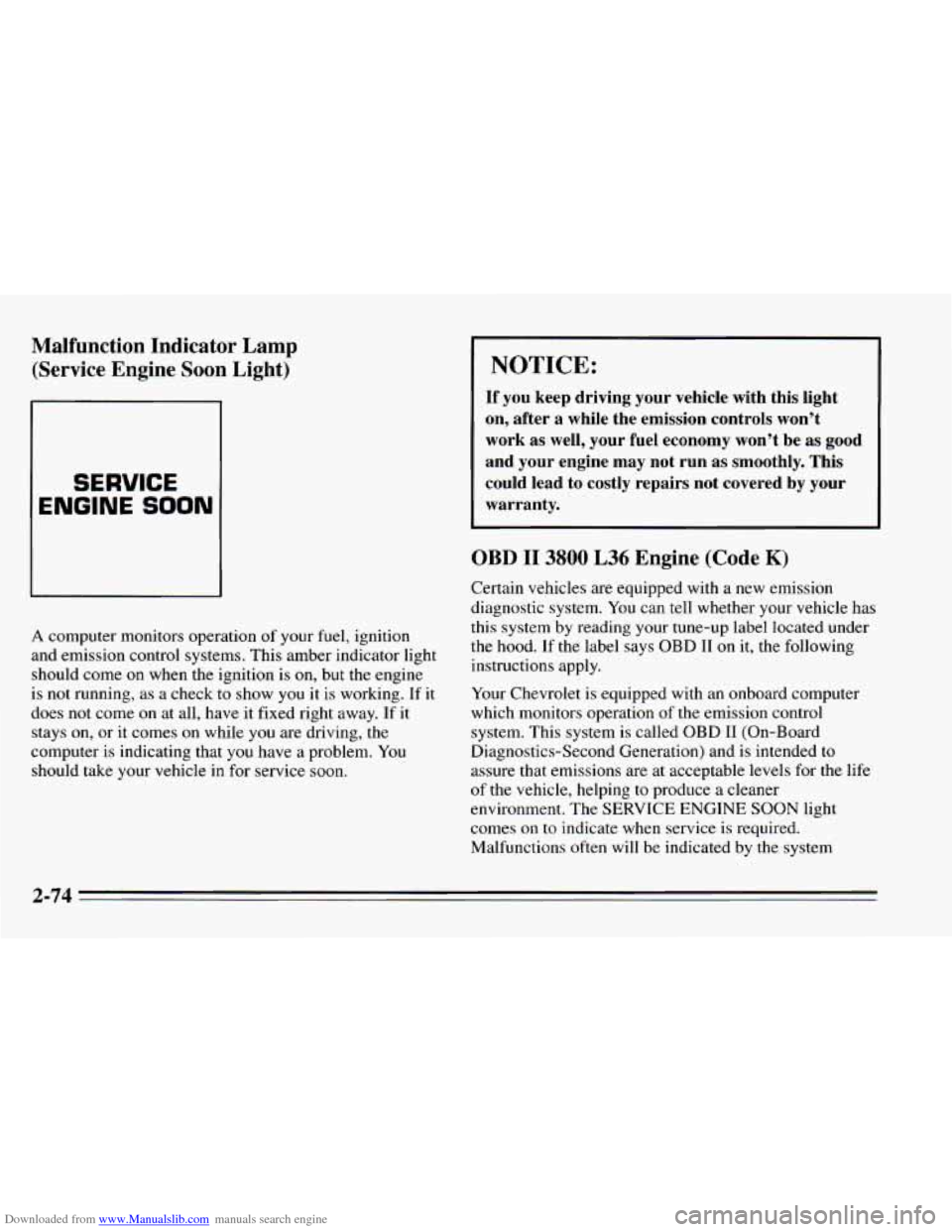
Downloaded from www.Manualslib.com manuals search engine Malfunction Indicator Lamp (Service Engine Soon Light)
SERVICE
ENGINE SOON
A computer monitors operation of your fuel, ignition
and emission control systems. This amber indicator light
should come
on when the ignition is on, but the engine
is
not running, as a check to show you it is working. If it
does not come on at all, have it fixed right away. If
it
stays on, or it comes on while you are driving, the
computer is indicating that you have a problem. You
should take your vehicle in for service soon.
NOTICE:
If you keep driving your vehicle with this light
on, after a while the emission controls won’t
work as well, your fuel economy won’t be as good
and your engine may not run
as smoothly. This
could lead to costly repairs not covered by your
warranty.
OBD I1 3800 L36 Engine (Code K)
Certain vehicles are equipped with a new emission
diagnostic system. You can tell whether your vehicle has
this system by reading your tune-up label Iocated under
the hood. If the label says OBD I1 on it, the following
instructions apply.
Your Chevrolet is equipped with an onboard computer
which monitors operation
of the emission control
system. This system is called
OBD I1 (On-Board
Diagnostics-Second Generation) and is intended
to
assure that emissions are at acceptable levels for the life
of the vehicle, helping to produce a cleaner
environment. The SERVICE ENGINE
SOON light
comes on to indicate when service is required.
Malfunctions often will be indicated by the system
2-74
Page 127 of 388
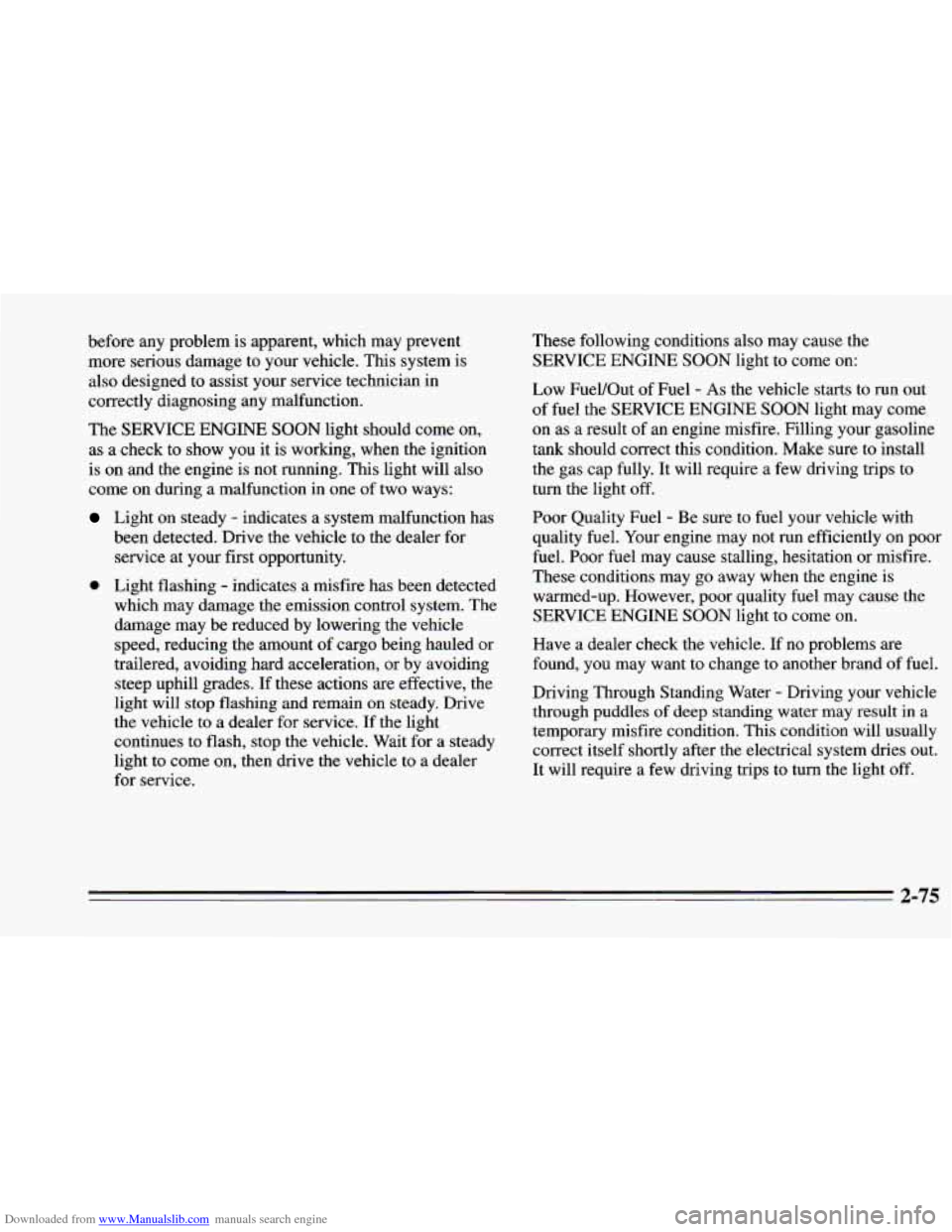
Downloaded from www.Manualslib.com manuals search engine before any problem is apparent, which may prevent
more serious damage to your vehicle. This system is
also designed to assist your service technician in
correctly diagnosing any malfunction.
The SERVICE ENGINE
SOON light should come on,
as a check to show you it is working, when the ignition
is on and the engine is not running. This light will also
come on during a malfunction in one of two ways:
Light on steady - indicates a system malfunction has
been detected. Drive the vehicle to the dealer for
service at your first opportunity.
0 Light flashing - indicates a misfire has been detected
which may damage the emission control system. The
damage may be reduced by lowering the vehicle
speed, reducing the amount of cargo being hauled or
trailered, avoiding hard acceleration, or
by avoiding
steep uphill grades. If these actions are effective, the
light will stop flashing and remain on steady. Drive
the vehicle to a dealer for service. If the light
continues to flash, stop the vehicle. Wait for
a steady
light to come on,
then drive the vehicle to a dealer
for service. These
following conditions also may cause the
SERVICE ENGINE SOON light to come on:
Low Fuel/Out of Fuel
- As the vehicle starts to run out
of fuel the SERVICE ENGINE SOON light may come
on as a result of an engine misfire. Filling your gasoline
tank should correct this condition. Make sure to install
the gas cap fully. It will require a few driving trips to
turn the light off.
Poor Quality Fuel
- Be sure to fuel your vehicle with
quality fuel. Your engine may not run efficiently on poor
fuel.
Poor fuel may cause stalling, hesitation or misfire.
These conditions may go away when the engine is
warmed-up. However, poor quality fuel may cause the
SERVICE ENGINE SOON light to come on.
Have a dealer check the vehicle. If
no problems are
found, you may want to change to another brand of fuel.
Driving Through Standing Water
- Driving your vehicle
through puddles
of deep standing water may result in a
temporary misfire condition. This condition will usually
correct itself shortly after the electrical system dries out.
It will require a few driving trips to turn the light off.
2-75
Page 131 of 388
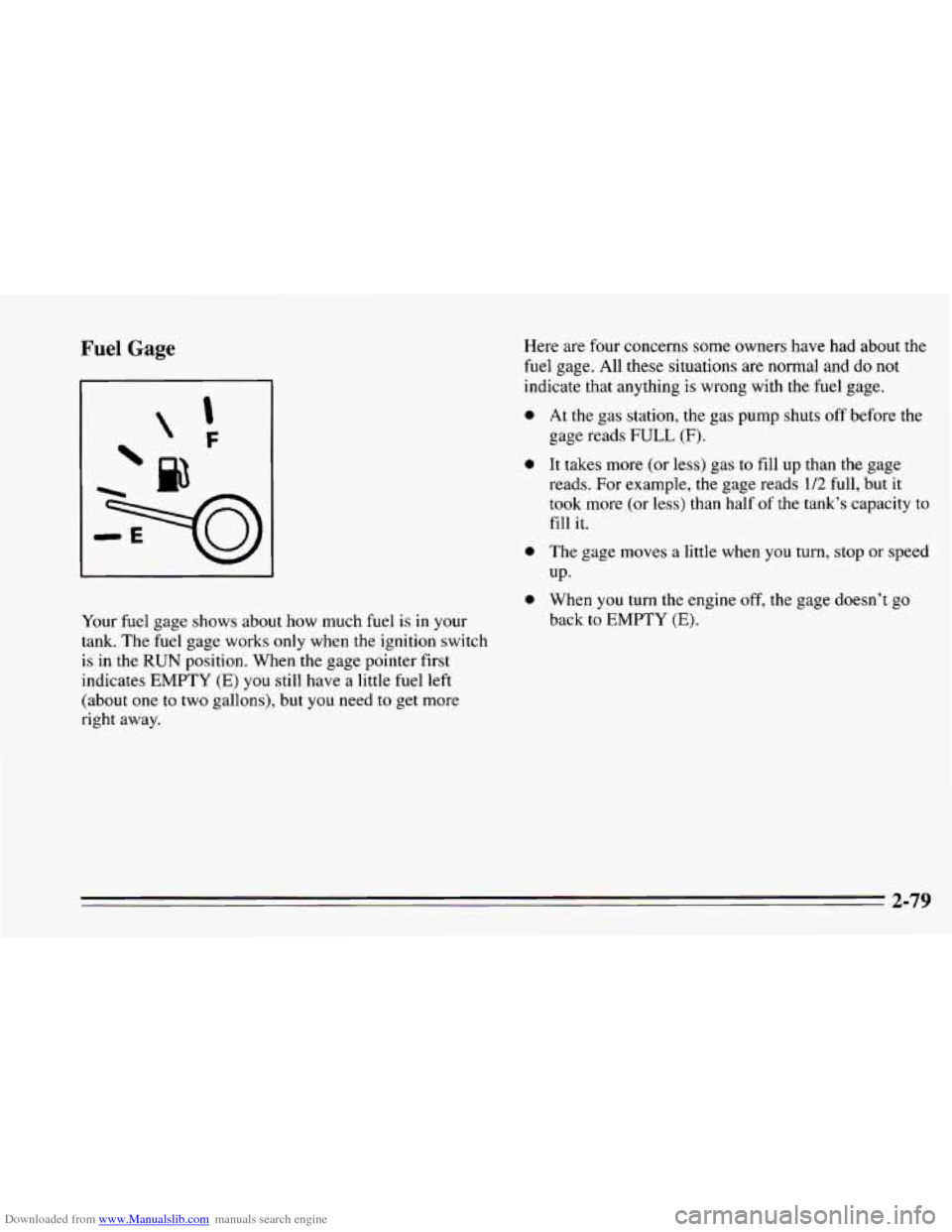
Downloaded from www.Manualslib.com manuals search engine Fuel Gage Here are four concerns some owners have had about the
fuel gage. All
these situations are normal and do not
indicate that anything is wrong with the fuel gage.
0
0
0
0
Your fuel gage shows about how much fuel is in your
tank. The fuel gage works only when the ignition switch
is in the RUN position. When the gage pointer first
indicates EMPTY
(E) you still have a little fuel left
(about
one to two gallons), but you need to get more
right away. At the
gas station,
the gas pump shuts off before the
gage reads
FULL (F).
It takes more (or less) gas to fill up than the gage
reads. For example, the gage reads 1/2 full, but
it
took more (or less) than half of the tank’s capacity to
fill
it.
The gage moves a little when you turn, stop or speed
UP.
When
you turn the engine off, the gage doesn’t PO
back to EMPTY (E),
Page 142 of 388
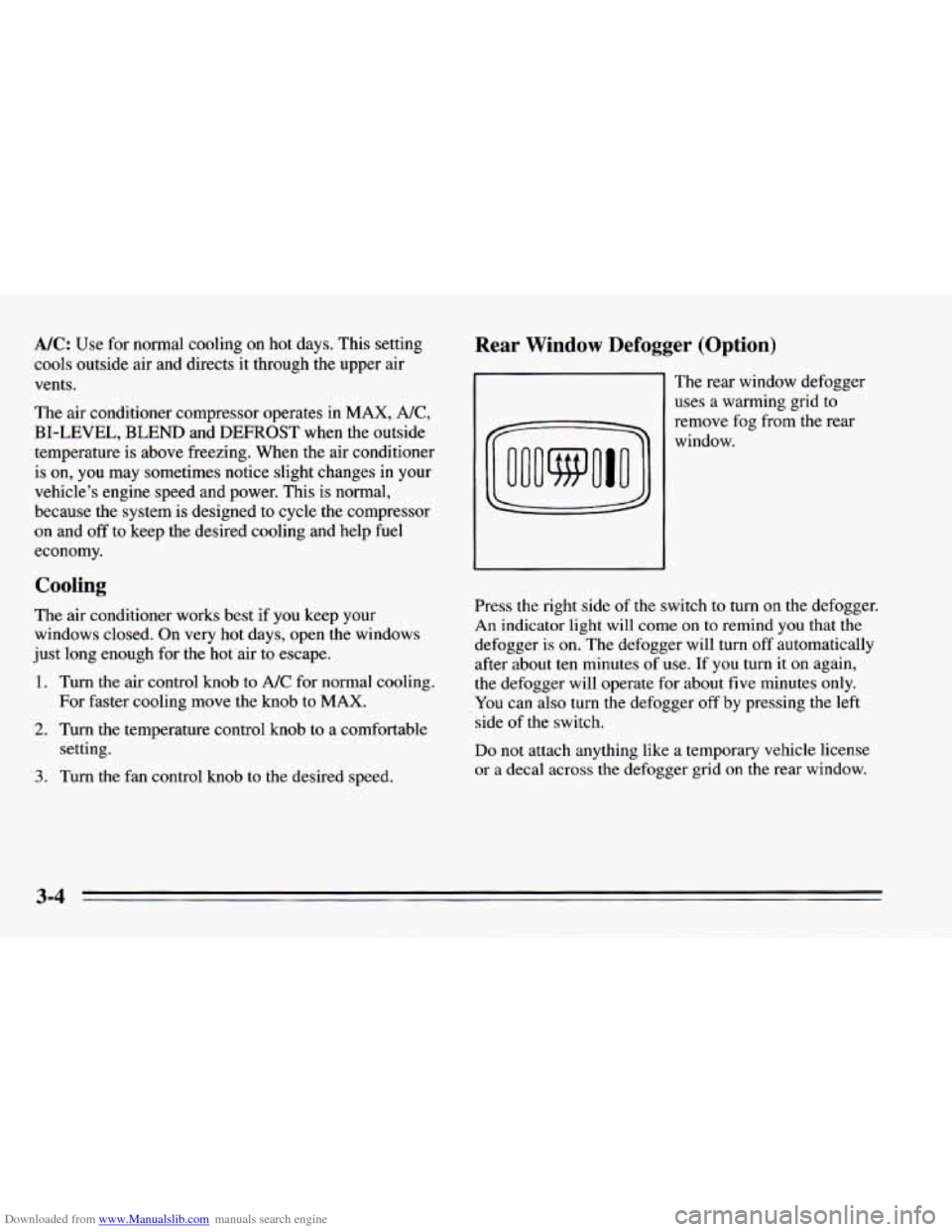
Downloaded from www.Manualslib.com manuals search engine A/C: Use for normal cooling on hot days. This setting
cools outside air and directs it through the upper air
vents.
The air conditioner compressor operates in
MAX, NC,
BI-LEVEL, BLEND and DEFROST when the outside
temperature
is above freezing. When the air conditioner
is on, you may sometimes notice slight changes in your
vehicle’s engine speed and power. This is normal,
because the system is designed to cycle the compressor
on and
off to keep the desired cooling and help fuel
economy.
Cooling
The air conditioner works best if you keep your
windows closed. On very hot days, open the windows
just long enough for the hot air to escape.
1. Turn the air control knob to A/C for normal coolinn.
For faster cooling move the knob to
MAX.
setting.
2. Turn the temperature control knob to a comfortable
3. Turn the fan control knob to the desired speed.
Rear Window Defogger (Option)
The rear window defogger
uses a warming grid to
remove fog
from the rear
window.
Press the right side of the switch to turn
on the defogger.
An indicator light will come on to remind you that the
defogger is on. The defogger will
turn off automatically
after about ten minutes of use.
If you turn it on again,
the defogger will operate for about five minutes only.
You can also turn the defogger
off by pressing the left
side of the switch.
Do not attach anything like a temporary vehicle license
or a decal across the defogger grid on the rear window.
3-4
Page 178 of 388
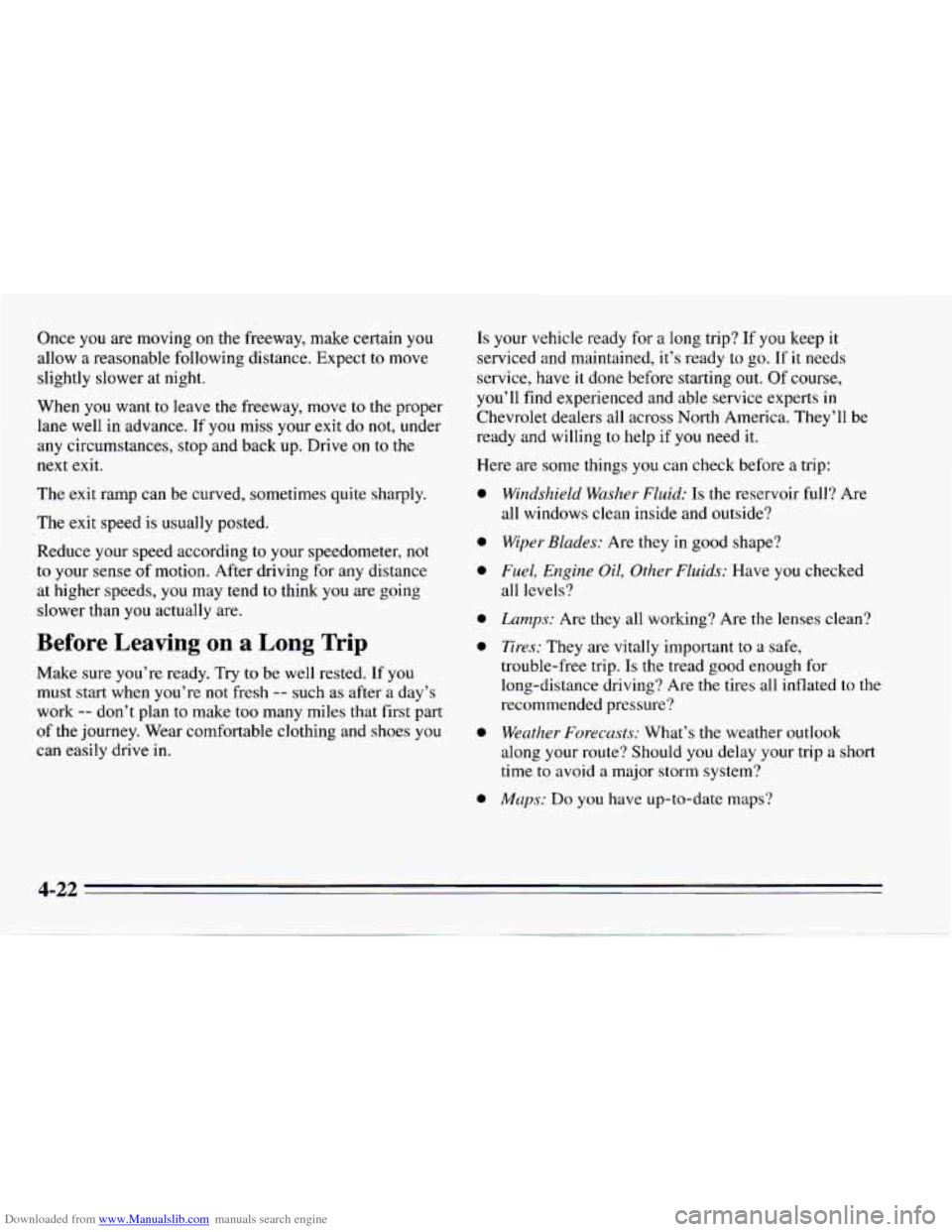
Downloaded from www.Manualslib.com manuals search engine Once you are moving on the freeway, make certain you
allow a reasonable following distance. Expect to move
slightly slower at night.
When you want to leave the freeway, move
to the proper
lane well in advance.
If you miss your exit do not, under
any circumstances, stop and back up. Drive
on to the
next exit.
The exit ramp can be curved, sometimes quite sharply.
The exit speed is usually posted.
Reduce your speed according to your speedometer,
not
to your sense of motion. After driving for any distance
at higher speeds, you may tend to think you are going
slower than you actually are.
Before Leaving on a Long Trip
Make sure you’re ready. Try to be well rested. If you
must start when you’re not fresh -- such as after a day’s
work
-- don’t plan to make too many miles that first part
of the journey. Wear comfortable clothing and shoes
you
can easily drive in.
Is your vehicle ready for a long trip? If you keep it
serviced and maintained, it’s ready to
go. If it needs
service, have it done before starting out.
Of course,
you’ll find experienced and able service experts
in
Chevrolet dealers all across North America. They’ll be
ready and willing to help if you need it.
Here are some things you can check before
a trip:
0
0
0
0
0
0
0
Windshield Washer Fluid: Is the reservoir full? Are
all windows clean inside and outside?
Wiper Blades: Are they in good shape?
Fuel, Engine Oil, Other Fluids: Have you checked
all levels?
Lumps: Are they all working? Are the lenses clean?
Tires: They are vitally important to a safe,
trouble-free trip.
Is the tread good enough for
long-distance driving? Are
the tires all inflated to the
recommended pressure?
Weather Forecasts: What’s the weather outlook
along your route? Should
you delay your trip a short
time to avoid a major storm system?
Maps: Do you have up-to-date maps?
4-22
Page 184 of 388
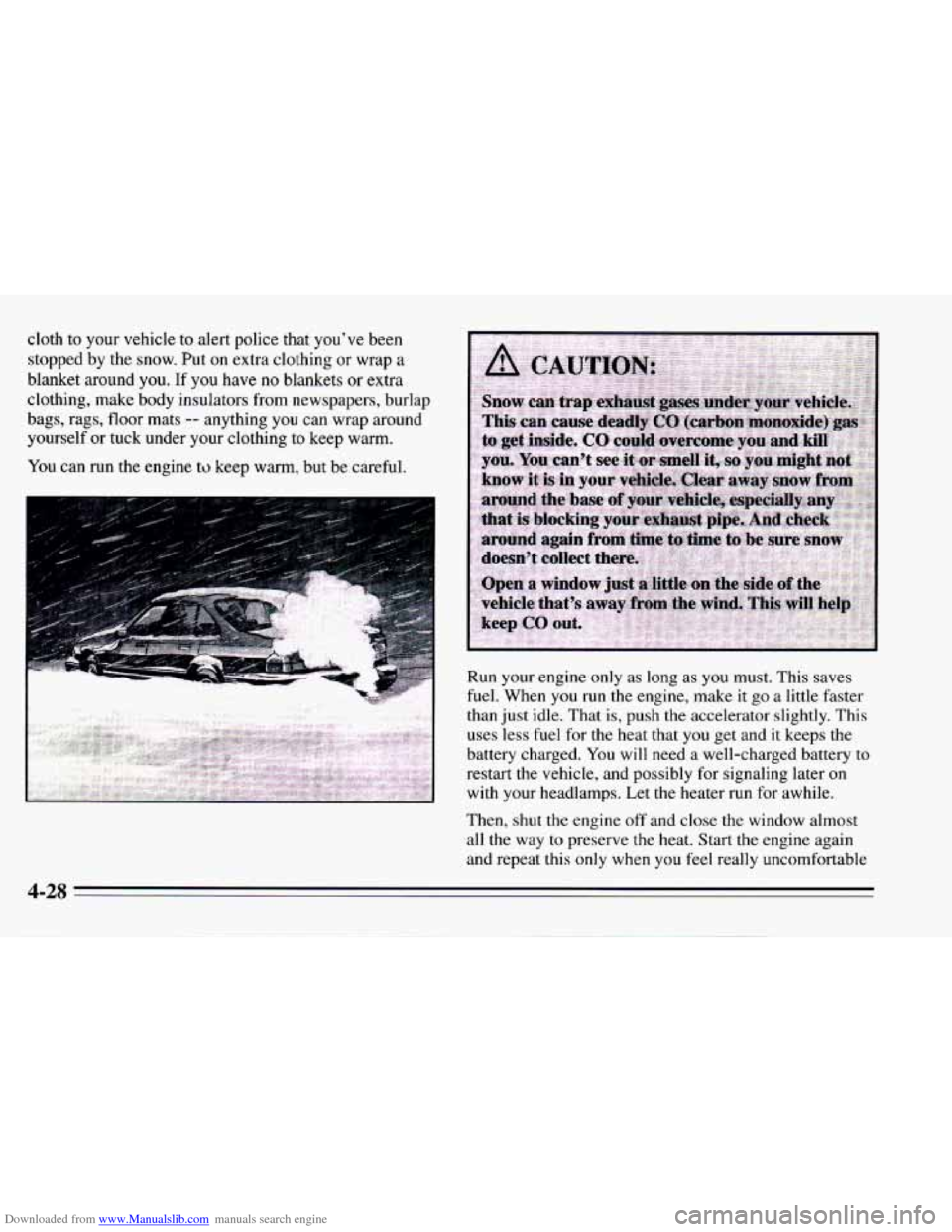
Downloaded from www.Manualslib.com manuals search engine cloth to your vehicle to alert police that you’ve been
stopped by the snow. Put
on extra clothing or wrap a
blanket around you. If you have no blankets or extra
clothing,
make body insulators from newspapers, burlap
bags, rags, floor mats
-- anything you can wrap around
yourself
or tuck under your clothing to keep warm.
You can
run the engine to keep warm, but be careful.
Run your engine only as long as you must. This saves
fuel. When you run the engine, make it
go a little faster
than just idle. That
is, push the accelerator slightly. This
uses less fuel for the heat that you get and it keeps the
battery charged. You
will need a well-charged battery to
restart the vehicle, and possibly for signaling later
on
with your headlamps. Let the heater run for awhile.
Then,
shut the engine off and close the window almost
all the way to preserve the heat. Start the engine again
and repeat this only when you feel really uncomfortable
4-28
. ..